Ascension of Jesus
| Ascension of Jesus | |
|---|---|
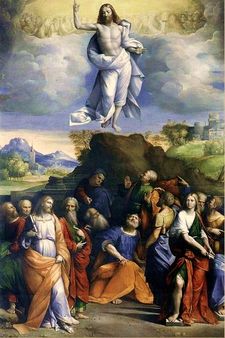 Ascension of Christ by Garofalo 1520 |
|
| Observed by | Christians |
| Type | Christianity |
| Significance | Affirmation of the ascension of Jesus |
| Date | Thursday[n 1] in the sixth week following Easter Sunday |
| 2010 date | May 13[n 1] |
| Celebrations | A traditional Christian Feast |
| Observances | Prayer |
| Related to | Passover, Christmas (which honors the birth of Jesus), Septuagesima, Quinquagesima, Shrove Tuesday, Ash Wednesday, Lent, Palm Sunday, Holy Thursday, Good Friday and Holy Saturday which lead up to Easter, Easter Sunday (primarily), Pentecost, Whit Monday, Trinity Sunday, and Corpus Christi which follow Easter |
| Liturgical year |
|---|
| Western |
| Eastern |
|
| Major events in Jesus' life from the Gospels |
|---|
|
The Christian doctrine of the Ascension holds that Jesus ascended to heaven in the presence of eleven of his Apostles following his resurrection, and that in heaven he sits at the right hand of God the Father.
Jesus died circa 30. In the Epistle to the Romans (c. 56-57),[1] Saint Paul describes Christ as in heaven and in the abyss[Rom. 10:5-7] the earliest Christian reference to Jesus in heaven. The fuller account of the Ascension, and according to the two-source hypothesis the earliest,[2] is in Acts of the Apostles[1:1-11] where Jesus is taken up bodily into heaven forty days after his resurrection as witnessed by his apostles, after giving the Great Commission with a prophecy to return. In the Gospel of Luke, there is no time marker to say when the Ascension took place. Some read the text of Luke literally and take the final four verses of the last chapter as if events were contiguous on the same day - i.e., the Ascension taking place on Easter Sunday evening.[3] Others hold the Ascension took place 40 days after the Resurrection based on Acts 1:3. The Gospel of John (c. 90-100)[4] refers to Jesus returning to the Father.[Jn. 20:17] Some [5] interpret 'Receive the Spirit' of John 20:22 as a possibly meaning that Jesus was then already ascended and glorified on the late Sunday of resurrection.
In the First Epistle of Peter (c. 90-110),[4] Jesus has ascended to heaven and is at God's right side.[1 Pet. 3:21-22] The Epistle to the Ephesians (c. 90-100)[4] refers to Jesus ascending higher than all the heavens.[Eph. 4:7-13] The First Epistle to Timothy (c. 90-140)[4] describes Jesus as taken up in glory.[1 Tim. 3:16] The appended ending of Mark[16:19] includes a summary of Luke's resurrection material and describes Jesus as being taken up into heaven and sitting at God's right hand. The imagery of Jesus' Ascension is related to the broader theme of his exaltation and heavenly welcome, derived from the Hebrew Bible.[6] The image of Jesus rising bodily into the heavens reflects the ancient view that heaven was above the earth.[7]
Belief in the Ascension of Jesus is found in the Nicene Creed, and is affirmed by Christian liturgy and, in the West, by the Apostles' Creed. The Ascension implies Jesus' humanity being taken into heaven.[6] Ascension Day, celebrated 40 days after Easter, is one of chief feasts of the Christian year.[6] The feast dates back at least to the later 300s, as is widely attested.[6]
The canonical account of Jesus ascending bodily into the clouds contrasts with the gnostic tradition, by which Jesus was said to transcend the physical realm and return to his home in the spirit world. It also contrasts with the beliefs of Docetism, in which matter is intrinsically evil and Jesus was said to have been pure spirit.
Contents |
Biblical accounts
One mention of the Ascension found in the Christian Bible is in the Gospel of Mark[16:14-19]—but see article on Mark 16. In one segment of the account, Jesus and the remaining eleven apostles are seated at a table. The passage summarizes a number of teachings attributed to Jesus: they are to spread the Gospel (see also Great Commission) and those who believe will be known by their ability to handle snakes without death by venom, to heal the sick, to cast out demons, to speak in "new tongues," and the like. The next segment in the most common, later ordering of the account states that after teaching these things, Jesus was received into heaven to sit at the right hand of God. No description of the Ascension itself is given; Mark simply states that it happened. This traditional but possibly non-canonical ending of Mark is considered a summary of Luke's resurrection appearances, commission, and ascension, plus miracles from the apostolic tradition.[8]
The Gospel of Luke[24:50-51] is even more brief in its description. Jesus led the eleven to Bethany, not far from Jerusalem. While in the act of blessing them, Jesus was carried up to heaven. Since Luke was once the first part of Luke-Acts, scholars surmise that this Ascension, different from that in [1:9-12], is from a different hand, perhaps created when Luke-Acts was divided into Luke and Acts.[3]
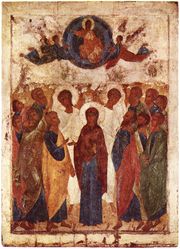
The third account of the Ascension is in the Acts of the Apostles.[1:9-12] For forty days after the Resurrection, Jesus continued to teach his followers. Jesus and the eleven were gathered near Mount Olivet, to the northeast of Bethany. Jesus tells his apostles that they will receive the power of the Holy Spirit, the "Comforter," see also Paraclete, and that they will spread his message the world over, i.e., the Great Commission. Jesus is taken up and received by a cloud. Two men clothed in white (i.e., angels) appear and tell the apostles that Jesus will return in the same manner as he was taken.
Even though these three accounts might appear contradictory, the reader should keep in mind that the original Gospels of Luke and Acts were both written by the same author and were thus very unlikely to contain such glaring discrepancies in their original form.[9]
Not only is the Ascension related in the passages of Scripture cited above, but it is also elsewhere predicted and spoken of as an established fact. Thus, Christ asks the Jews: "What if then you shall see the Son of Man ascend up where He was before?"[Jn 6:62] and to Mary Magdalene Jesus said, "Do not hold on to me, for I have not yet returned to the Father. Go instead to my brothers and tell them, 'I am returning to my Father and your Father, to my God and your God.' " 20:17 In Acts,[2:30-33] Ephesians,[4:8-10] and 1 Timothy[3:16] the Ascension of Christ is spoken of as an accepted fact, while Hebrews[10:12] describes Jesus as seated in heaven.
The Gospel of Matthew ends[28:18-20] at a mountain in Galilee with Jesus commanding the Disciples to spread the Gospel to the ends of the world, baptizing in the name of the Father, the Son, and the Holy Spirit (the "Great Commission"). No mention is made there of the Ascension.
The Catholic and Orthodox traditional view is that Mary was also present at the Ascension, following her mention in Acts 1.
Extra-biblical accounts
Outside of the Biblical Canon, the Ascension is discussed in the Pistis Sophia. Irenaeus in Against Heresies notes the Gnostic view that the Ascension happened eighteen months after the Resurrection.[10] The apocryphal text known as the Apocryphon of James describes the teachings of Jesus to James and Peter 550 days after the resurrection, but before the ascension, suggesting an even longer period. The recently discovered Nag Hammadi Gospel of Thomas, like the canonical Gospel of Matthew, does not mention the Ascension.
Location
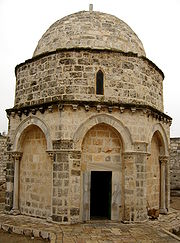
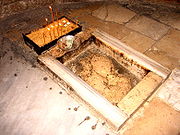
The place of the Ascension is not distinctly mentioned in the Gospel of Mark. Luke 24:50 states that the event took place in Bethany while it appears from Acts that it took place on the Mount Olivet (the "Mount of Olives"). After the Ascension the apostles are described as returning to Jerusalem from the mount that is called Olivet, which is near Jerusalem, within a Sabbath day's journey. Tradition has consecrated this site as the Mount of Ascension.
Before the conversion of Constantine in 312 A.D., early Christians honored the Ascension of Christ in a cave on the Mount of Olives. By 384, the place of the Ascension was venerated on the present open site, uphill from the cave.[11]
The Chapel of the Ascension in Jerusalem today is a Christian and Muslim holy site now believed to mark the place where Jesus ascended into heaven. In the small round church/mosque is a stone imprinted with what some claim to be the very footprints of Jesus.[11]
St. Helena erected over the site a basilica called "Eleona Basilica" (elaion in Greek means "olive garden", from elaia "olive tree," and has an oft-mentioned similarity to eleos meaning "mercy") in 392, which was destroyed by the Sassanid Persians in 614. It was rebuilt in the eighth century, destroyed again, but rebuilt a second time by the Crusaders. This final church was also destroyed by Muslims, leaving only the octagonal structure (called a martyrium—"memorial"—or "Edicule") which remains to this day.[12]
The site was ultimately acquired by two emissaries of Saladin in the year 1198 and has remained in the possession of the Islamic Waqf of Jerusalem ever since. The martyrium, though now only bare stone, enshrines the rock said to bear the imprint of the right foot of Christ as he ascended, and is venerated by Catholic Christians as the last point on earth touched by the incarnate Christ. The Crusader building was converted to a mosque but was never used by Muslims since the overwhelming majority of visitors were Christian. As a gesture of compromise and goodwill, Saladin ordered the construction of a second mosque and mihrab two years later next door to the chapel for Muslim worship while Christians continued to visit the main chapel. Though still under the control of the Muslims, this Chapel of the Ascension is currently opened to visitors for a nominal fee.[13]
The Russian Orthodox Church also maintains a Convent of the Ascension on the top of the Mount of Olives.
Historicity
The Jesus Seminar rejects the New Testament accounts of Jesus' ascension as inventions of the Christian community in the Apostolic Age.[3] They describe the Ascension as a convenient device to discredit ongoing appearance claims within the Christian community.[3]
Christian theology
Eastern and Oriental Christianity
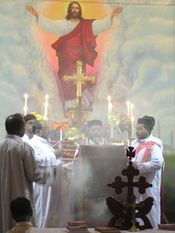
In Eastern Orthodox and Oriental Orthodox theology, the Ascension is interpreted as the culmination of the Mystery of the Incarnation, in that it not only marked the completion of Jesus' physical presence among his apostles, but consummated the union of God and man when Jesus ascended in his glorified human body to sit at the right hand of God the Father. The Ascension and the Transfiguration both figure prominently in the Orthodox doctrine of theosis. The bodily Ascension into heaven is also understood as the final token of Christ's two natures: divine and human.[14]
The Orthodox doctrine of salvation points to the Ascension to indicate that the state of redeemed man is higher than the state of man in Paradise before the fall.
The Orthodox understand Christ's physical presence to continue in the Church, which is the "Body of Christ".[1 Cor 12:12-27] Jesus' promise that he will be "with you always" is understood not only in terms of his active, divine grace, but also in the divine institution of the church (human sinfulness notwithstanding).
Christ's Ascension into heaven is understood as a necessary prerequisite for the sending of the Holy Spirit at Pentecost,[Jn 14:15-20] [14:25-28] [15:26] and especially [16:7] The biblical texts regarding the Ascension also prophesy the Second Coming of Christ, stating that Jesus will return not only in the same glorious manner, but in the same place. In other words, the Second Coming and Last Judgment will take place on the Mount of Olives, with the Valley of Hinnom (Gehenna) below and to the left.
Reformed tradition in Protestantism
The Westminster Confession of Faith (part of the Reformed tradition in Calvinism and influential in the Presbyterian church), in Article four of Chapter eight, states: "On the third day He arose from the dead, with the same body in which He suffered, with which also he ascended into heaven, and there sits at the right hand of His Father, making intercession, and shall return, to judge men and angels, at the end of the world."[15]
Article 46 of the Heidelberg Catechism answers the question What do you confess when you say, He ascended into heaven? by stating "That Christ, before the eyes of His disciples, was taken up from the earth into heaven, and that He is there for our benefit until He comes again to judge the living and the dead."[15]
The Catechism further explores aspects of the ascension, asking How does Christ's ascension into heaven benefit us? and replying, "First, He is our Advocate in heaven before His Father. Second, we have our flesh in heaven as a sure pledge that He, our Head, will also take us, His members, up to Himself. Third, He sends us His Spirit [...]"[15]
The Second Helvetic Confession addresses the purpose and character of Christ's ascension in Chapter 11:[15]
- Christ Is Truly Ascended Into Heaven. We believe that our Lord Jesus Christ, in his same flesh, ascended above all visible heavens into the highest heaven, that is, the dwelling-place of God and the blessed ones, at the right hand of God the Father. Although it signifies an equal participation in glory and majesty, it is also taken to be a certain place about which the Lord, speaking in the Gospel, says: 'I go to prepare a place for you' (John 14:2). The apostle Peter also says: 'Heaven must receive Christ until the time of restoring all things' (Acts 3:21).
Feast
| Year | Western[n 1] | Eastern |
|---|---|---|
| 2000 | June 1 | June 8 |
| 2001 | May 24 | |
| 2002 | May 9 | June 13 |
| 2003 | May 29 | June 5 |
| 2004 | May 20 | |
| 2005 | May 5 | June 9 |
| 2006 | May 25 | June 1 |
| 2007 | May 17 | |
| 2008 | May 1 | June 5 |
| 2009 | May 21 | May 28 |
| 2010 | May 13 | |
| 2011 | June 2 | |
| 2012 | May 17 | May 24 |
| 2013 | May 9 | June 13 |
| 2014 | May 29 | |
| 2015 | May 14 | May 21 |
| 2016 | May 5 | June 9 |
| 2017 | May 25 | |
| 2018 | May 10 | May 17 |
| 2019 | May 30 | June 6 |
| 2020 | May 21 | May 28 |
|
||
The Ascension is one of the great feasts in the Christian liturgical calendar, and commemorates the bodily Ascension of Jesus into heaven. Ascension Day is traditionally celebrated on a Thursday, the fortieth day from Easter day. However, some Roman Catholic provinces have moved the observance to the following Sunday. The feast is one of the ecumenical feasts (i.e., universally celebrated), ranking with the feasts of the Passion, of Easter and Pentecost.
History
The observance of this feast is of great antiquity. Although no documentary evidence of it exists prior to the beginning of the fifth century, St. Augustine says that it is of Apostolic origin, and he speaks of it in a way that shows it was the universal observance of the Church long before his time. Frequent mention of it is made in the writings of St. John Chrysostom, St. Gregory of Nyssa, and in the Constitution of the Apostles. The Pilgrimage of Aetheria speaks of the vigil of this feast and of the feast itself, as they were kept in the church built over the grotto in Bethlehem in which Christ was born. [16] It may be that prior to the fifth century the fact narrated in the Gospels was commemorated in conjunction with the feast of Easter or Pentecost. Some believe that the much-disputed forty-third decree of the Council of Elvira (c. 300) condemning the practice of observing a feast on the fortieth day after Easter and neglecting to keep Pentecost on the fiftieth day, implies that the proper usage of the time was to commemorate the Ascension along with Pentecost. Representations of the mystery are found in diptychs and frescoes dating as early as the fifth century.
Western
The Latin terms used for the feast, ascensio and, occasionally, ascensa, signify that Christ was raised up by his own powers, and it is from these terms that the holy day gets its name. The Book of Common Prayer of the Anglican Church treats "Holy Thursday" as an alternative name for Ascension Day.[17][18] In Roman Catholicism the Ascension of the Lord is a Holy Day of Obligation. The three days before Ascension Thursday are sometimes referred to as the Rogation days and the previous Sunday, the Sixth Sunday of Easter (or the Fifth Sunday after Easter), as Rogation Sunday. Ascension has a vigil and, since the fifteenth century, an octave, which is set apart for a novena of preparation for Pentecost, in accordance with the directions of Pope Leo XIII.
In Western Christianity, the earliest possible date is April 30, the latest possible date is June 3.
Sunday observance
The Roman Catholic Church in a number of countries has obtained permission from the Vatican to move observance of the Feast of the Ascension from the traditional Thursday to the following Sunday, the Sunday before Pentecost. This is in keeping with a trend to move Holy Days of Obligation from weekdays to Sunday, to encourage more Catholics to observe feasts considered important.[19] The decision to move a feast is made by the bishops of an ecclesiastical province, i.e. an archbishop and the neighbouring bishops. The switch to Sunday was made in 1992 by the church in Australia;[20] before 1996 in parts of Europe;[21] in 1996 in Ireland;[22] before 1998 in Canada and parts of the western United States;[19] in many other provinces in the United States from 1999;[19] and in England and Wales from 2007.[23] The U.S. provinces which retain Thursday observance in 2009 are Boston, Hartford, New York, Newark, Omaha, and Philadelphia.[24]
Eastern
In the Eastern Church this feast is known in Greek as Analepsis, the "taking up", and also as the Episozomene, the "salvation from on high", denoting that by ascending into his glory Christ completed the work of our redemption. Ascension is one of the Twelve Great Feasts of the Orthodox liturgical year.
The feast is always observed with an All-night vigil. The day before is the Apodosis (leave-taking) of Pascha (i.e., the last day of the Feast of Easter). The Paroemia (Old Testament readings) at Vespers on the eve of the Feast are Isaiah 2:2-3; Isaiah 62:10-63:3, 63:7-9; and Zecheriah 14:1-4, 14:8-11. At the Divine Liturgy, the Epistle is Acts 1:1-12, and the Gospel is Luke 24:36-53. Ascension Thursday also commemorates the Holy Georgian Martyrs of Persia (17th–18th centuries).
Ascension has an Afterfeast of eight days. The Sunday after Ascension is the Sunday of the Holy Fathers of the First Ecumenical Council at Nicaea. This council formulated the Nicene Creed up to the words, "He (Jesus) ascended into heaven, and sits at the right hand of the Father; and shall come again, with glory, to judge the living and the dead; Whose kingdom shall have no end." The Afterfeast ends on the following Friday, the Friday before Pentecost. The next day is appropriately a Saturday of the Dead (general commemoration of all faithful departed).
The Eastern Orthodox Church uses a different method of calculating the date of Pascha (Easter), so the Eastern Orthodox commemoration of Ascension will usually be after the western observance (anywhere from a week to as much as a month later; but occasionally on the same day). The earliest possible date for the feast is May 13, and the latest possible date is June 17. Some of the Oriental Orthodox Churches, however, observe Ascension on the same date as the Western Churches.[25]
Customs
Certain customs were connected with the liturgy of this feast, such as the blessing of beans and grapes after the Commemoration of the Dead in the Canon of the Mass, the blessing of first fruits, afterwards done on Rogation Days, the blessing of a candle, the wearing of mitres by deacon and subdeacon, the extinguishing of the paschal candle, and triumphal processions with torches and banners outside the churches to commemorate the entry of Christ into heaven.
The antiquarian Daniel Rock records the English custom of carrying at the head of the procession the banner bearing the device of the lion and at the foot the banner of the dragon, to symbolize the triumph of Christ in his ascension over the evil one (and can also be interpreted by analogy as the triumph of England over Wales). In some churches the scene of the Ascension was vividly reproduced by elevating the figure of Christ above the altar through an opening in the roof of the church. In others, whilst the figure of Christ was made to ascend, that of the devil was made to descend.
In England it was once common for churches to "beat the bounds" on this day, and some continue the custom (e.g. the church of St Michael at the North Gate in Oxford). Members of the parish walk round the parish boundaries, marking boundary stones (e.g. by writing on them in chalk) and hitting them with sticks. According to some, it was once the young boys of the parish that were hit with sticks instead of the stones. Knowledge of the parish boundaries was once important, since churches had certain duties such as the care of children born out of wedlock in the parish. One of the purposes served by beating the bounds was that of warning the young men of the parish that any sexual misbehaviour ought to take place with women who lived outside the parish.
In some countries (e.g. Austria, Belgium, Croatia, Denmark, Finland, France, Germany, Iceland, Indonesia, Netherlands, Norway, Sweden, Switzerland and Vanuatu) it is a public holiday; Germany also holds its Fathers' Day on the same date.
Coinciding with the liturgical feast is the annual commemoration by the Christian labour movement (especially syndical, in Belgium) of the encyclical Rerum Novarum issued by the Roman Catholic Pope Leo XIII on May 15, 1891.
In Venice the ceremony of the Wedding with the Sea was traditionally celebrated on the Feast of the Ascension, while in Florence the Feast was observed by having a dove slide down a string from the high altar of the cathedral to ignite a large decorative container filled with fireworks in front of the main entrance of the cathedral.
See also
- Church of the Ascension
Notes
- ↑ Harris, Stephen L., Understanding the Bible. Palo Alto: Mayfield. 1985. p. 321
- ↑ The account in Acts was originally in Luke-Acts. The short account of Ascension in Luke is a condensed of this fuller account in Acts Chapter one, presumably by the same author. The Ascension is only mentioned in the revised ending to the gospel of Mark, based on Luke, added to Mark in the second century. Funk, Robert W. and the Jesus Seminar. The acts of Jesus: the search for the authentic deeds of Jesus. HarperSanFrancisco. 1998.
- ↑ 3.0 3.1 3.2 3.3 Funk, Robert W. and the Jesus Seminar. The acts of Jesus: the search for the authentic deeds of Jesus. HarperSanFrancisco. 1998. "Empty Tomb, Appearances & Ascension" p. 449-495.
- ↑ 4.0 4.1 4.2 4.3 Harris, Stephen L., Understanding the Bible. Palo Alto: Mayfield. 1985.
- ↑ John Marsh, Saint John - The Pelican New Testament Commentaries: Harmondsworth, England: Penguin Books. 1968. pp. 639-643
- ↑ 6.0 6.1 6.2 6.3 "Ascension of Christ." Cross, F. L., ed. The Oxford dictionary of the Christian church. New York: Oxford University Press. 2005
- ↑ Ehrman, Bart. Peter, Paul, and Mary Magdalene: The Followers of Jesus in History and Legend. Oxford University Press, USA. 2006. ISBN 0-19-530013-0
- ↑ May, Herbert G. and Bruce M. Metzger. The New Oxford Annotated Bible with the Apocrypha. 1977.
- ↑ Bruce M. Metzger's Textual Commentary on the Greek New Testament: Luke 24:51 is missing some important early witnesses; Acts 1 varies between the Alexandrian and Western versions.
- ↑ Irenaeus Against Heresies I.XXX.14
- ↑ 11.0 11.1 "Chapel of the Ascension, Jerusalem," Sacred Destinations. Web: 4 Apr 2010. <http://www.sacred-destinations.com/israel/jerusalem-chapel-of-ascension Chapel of the Ascension, Jerusalem>
- ↑ "The Chapel of Ascension." Web: 4 Apr 2010. <http://www.mtolives.com/sites/chapel-of-the-ascension.html Chapel of the Ascension>
- ↑ Bréhier, Louis. "Crusades." The Catholic Encyclopedia. Vol. 4. New York: Robert Appleton Company, 1908. 4 Apr. 2010 <http://www.newadvent.org/cathen/04543c.htm Crusades>
- ↑ St. Leo the Great, Tome, Section V.
- ↑ 15.0 15.1 15.2 15.3 Redman, Gary. "A Comparison of the Biblical and Islamic Views of the States of Christ/ Part 2: The State of Exaltation". The Muslim-Christian Debate Website. http://debate.org.uk/topics/theo/states_christ_03.html. Retrieved 2007-06-22.
- ↑ Louis Duchesne, Christian Worship: Its Origin and Evolution (London, 1903), 491-515.
- ↑ "The Christian Year: Ascension Day". The Prayer Book Society of Canada. http://www.prayerbook.ca/bcp/propers.html#ascension. Retrieved 2009-04-11.
- ↑ "Tables and Rules for the Moveable and Immoveable Feasts". Scottish Episcopal Church. http://justus.anglican.org/resources/bcp/Scotland/Scot_Tables_Rules.htm. Retrieved 2009-04-11.
- ↑ 19.0 19.1 19.2 Ascension Day is Moving Michael Kwatera, OSB. Office of Worship, Diocese of Saint Cloud.
- ↑ "Column 8". Sydney Morning Herald: p. 1. 14 May 1992.
- ↑ "Church holy day changes sought". The Irish Times: p. 5. 10 October 1996. http://www.irishtimes.com/newspaper/ireland/1996/1010/96101000034.html. Retrieved 2009-06-11.
- ↑ Pollak, Andy (17 October 1996). "Holy days moved to following Sunday". The Irish Times: p. 7. http://www.irishtimes.com/newspaper/ireland/1996/1017/96101700054.html. Retrieved 2009-06-11.
- ↑ The Spectator's Notes: Charles Moore's reflections on the week, Charles Moore The Spectator, Wednesday, 7th May 2008
- ↑ Is Ascension a Holy Day of Obligation? Scott P. Richert, About.com
- ↑ "The Church in Malankara switched entirely to the Gregorian calendar in 1953, following Encyclical No. 620 from Patriarch Mor Ignatius Aphrem I, dt. December 1952." Calendars of the Syriac Orthodox Church. Retrieved 22 April 2009.
External links
- Ascension of Jesus Christ
- Catholic Encyclopedia: Ascension
- The Ascension of our Lord Orthodox Icon and Synaxarion
- The Ascension of the Lord S. V. Bulgakov, Manual for Church Servers (theology and symbolism of the Feast)
- The Chapel of the Ascension Studium Biblicum Franciscanum, Jerusalem
- Chapel of the Ascension, Jerusalem Detailed description, history and photos
- Convent of the Ascension Jerusalem Mission, Russian Orthodox Church